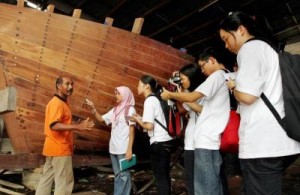In themiddle of Hasni Ali’s shipyard in Pulau Duyong, Kuala Terengganu, Terengganu lies the frames of two large, imposing wooden boats. You can tell that the boats are far from being completed, and yet all Hasni can do now is sit around and wait.
Months and months of hard work have gone into the two boats, with Hasni, 65, drawing on four generations’ worth of skill, knowledge and craftsmanship – and no little amount of financial commitment – to create the massive solid wood frames.
But Hasni, who learned the trade from his father, cannot afford to start work on the interior. He cannot afford to order any more of the increasingly costly cengal wood used for traditional Pulau Duyong boats. He cannot afford to pay any of the few skilled workers left on the island. The boats are grounded and dead in the water at the same time.
A man of few words, Hasni explained simply: “We had to stop work because the client who ordered the boats ran out of money. There’s nothing we can do.”
So the two unfinished boats lie in his simple shipyard, taking up all the space he has. He can’t take any new orders, and he can’t just scrap the current ones either because they’re already half done.
Unfortunately, Hasni’s plight tells the bigger story of the once thriving boat-making industry in Pulau Duyong, where skilled craftsmen have been making boats for hundreds of years relying on traditional knowledge, no blueprints, and the most basic tools.
Clients used to be from around the world, with Hasni having built boats for enthusiasts from Germany, England, Australia, Italy and France.
Hasni’s brother Ahmad, 59, also helps out in the company, called Bot Tradisional Duyong Enterprise, and he said: “The foreign clients buy from us because they appreciate the craftsmanship. They are impressed because we can build our boats without blueprints.”
But now, all that’s left of this proud tradition are three workshops, all of which are struggling to compete with the comparatively low cost of building modern fiberglass boats.
According to a local who didn’t want to be named, traditional boats often cost over a million ringgit, whereas fiberglass boats can be bought for several hundred thousand ringgit. The high price is because of the craftsmanship involved and the raw materials.
“We use cengal because it is durable and termite-resistant,” said Hasni. “It can take up to 80 tonnes of wood to make one boat, and one tonne of cengal costs RM13,000. It was RM5,000 just five years ago.”
Perhaps it’s a sign of desperation, but Ahmad has taken to building and selling wooden porch swings with leftover wood while the company waits for the client to find the funds necessary to complete the two boats.
In Pulau Duyong itself, boat-making is still seen as an honourable profession, and artisans like Hasni are well-respected.
Boat maker-turned-fisherman Mazurki Rani, for instance, admires Hasni for his determination to keep the tradition alive.
“Most of the younger generation in Pulau Duyong look up to people like Hasni, and many hope to follow in his footsteps when they grow up,” said Mazurki.
Local youngster Idham Mulaqqim, 13, who was running around Hasni’s workshop, said: “I want to be a boat maker some day. The way they make the boats is very interesting.”
While the sentiment is nice, whether these young people actually take up the challenge is another matter altogether.
Skilled boat makers can only earn up to RM70 a day, while partially-skilled makers earn less than RM50 working from 8am to 5pm.
Mazurki himself ditched boat-making because money was too hard to come by, especially when it can take over a year of hard work to finish the larger fishing vessels.
The job isn’t exactly safe either. The boats are around 15-20 feet tall when on the ground, and workers do not have any proper scaffolding to do their work on.
“Traditional boat-making is dangerous,” said Mazurki. “I once fell fifteen feet from the top of a boat because I wasn’t paying attention. I was lucky I didn’t get hurt.”
The industry has been getting some help from the government, particularly in 2005 when then Prime Minister Tun Abdullah Ahmad Badawi initiated the Monsoon Cup yacht race, which was held in Kuala Terengganu.
The event was aimed at boosting tourism in Kuala Terengganu, and was held in Pulau Duyong itself in 2009.
Kraftangan Malaysia have also done their part by commissioning a RM3.5mil sailboat from Hasni, which now sits proudly on the jetty outside his workshop, and organising boat-making courses in Pulau Duyong for young people.
Ahmad, however, fears that might not be enough: “What they learn in the course are only theories, there was no practical aspect to it. Some of them don’t even know the names of the tools!
“There’s only one way to learn how to build boats like these,” he added, pointing to the unfinished boats. “You have to try doing it with your own two hands.


Tell us what you think!